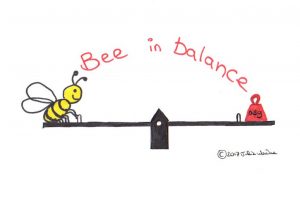 In the Hitchhiker’s guide to the galaxy, Douglas Adams’ famously cited the answer to life, the universe and everything as ‘42’. Looking at this ‘ultimate question’ from the perspective of an Alexander Technique teacher, I’d suggest that a more helpful and plausible answer might be ‘balance’.
In the Hitchhiker’s guide to the galaxy, Douglas Adams’ famously cited the answer to life, the universe and everything as ‘42’. Looking at this ‘ultimate question’ from the perspective of an Alexander Technique teacher, I’d suggest that a more helpful and plausible answer might be ‘balance’.
Whether it’s life balance, balance in movement, or emotional balance – balance is something most of us aspire to. Perhaps surprisingly, even in such everyday activities as sitting or standing, we do not readily or regularly achieve a state of physical balance. Balance is a dynamic process and habits such as locking knees and other joints will interfere with this, as any rigidity prevents the natural and very subtle postural sway. Our physical balance is also affected by our tendency to ‘live in the future’ rather than being in the present moment, with our minds one step ahead of our bodily selves. For example, while I’m reaching out for something, my mind tends to already be onto the next action – thinking what I’m going to be doing with the object I’m just about to take hold of. The result can be that I very readily pull myself slightly off balance in reaching out, rather than allowing myself to take that necessary extra step closer. Unless we are in balance, we have to over-use muscles in order to stay upright and in position. So frequently being slightly off balance is one source of excess muscular tension.
In Alexander Technique lessons, people learn how to come into a state of balance and how to maintain this while moving, standing, sitting etc – they’re often surprised by the experience of ease and pleasure that this brings. They also learn how to use awareness and intention to carry this through into the rest of their daily lives – discovering how to find better balance in everyday activities, reducing the habitual tension patterns that are no longer needed to ‘hold themselves up’.
Equally as desirable as ‘physical’ balance is ‘mental’ or ‘emotional’ balance. When we’re in a state of equilibrium we feel more able to deal with the world and calmly consider different options or perspectives, without jumping to a decision or viewpoint based solely on preconceived ideas or simple habit. When we practise Alexander thinking we can find a better ‘mental / emotional’ balance. Rather than just reacting immediately in a ‘knee-jerk’ habitual way, we learn to give ourselves more space and time in which we can choose whether and how to respond to what life throws at us. And in that brief moment of non-responding, as we bring our awareness to ourselves and form a clear intention of what we do and don’t want, everything has a chance to organise and we come into a better state of physical balance. And vice versa – so if, for example, I’m nicely balanced on my sitting bones on the chair while typing this, I’m going to feel a bit calmer than I would if I were hunched over my computer. So, from an Alexander perspective, we’re not composed of separate physical and mental entities but as one mind-body self. A better sense of ourselves as embodied beings leaves us better placed to tackle life’s ‘ups and downs’.
We’re encouraged by our culture to look for certainty and absolutes (‘work as hard as you can’ rather than ‘do a good job and go home at a reasonable time’; ‘be the fastest’ rather than just ‘enjoy your run’; ‘make sure you make the right choice’ rather than ‘weigh it all up and go with what seems the best option’ etc). However, very little in life is black and white, and extremes in any aspect of life are generally not desirable. We sometimes set ourselves unrealistic goals and then give up disheartened when we don’t immediately achieve the desired outcome.
As we begin to apply the Alexander Technique in our daily lives we become more aware of the physical and thinking habits that tend to pull us off balance, and we learn how to reduce this interference. We also discover that when our intention is clear, we are more able to focus on the desired direction of travel and to fixate less on wanting immediate results.
It’s not about trying to achieve some state of perfect balance in all things and at all times, but rather, by using the Alexander Technique we can continue to find a better balance in our lives. In a nutshell, the Alexander Technique is about awareness, intention and balance. Greater awareness of ourselves, together with clear intention, tend to lead to better balance (in all senses of the word) both in the moment and for the long term.